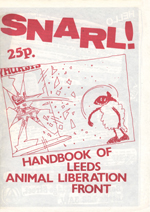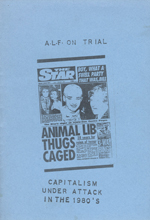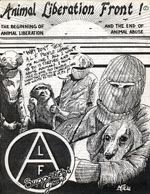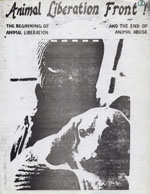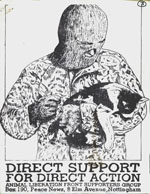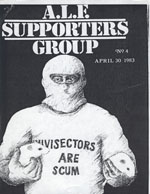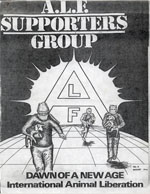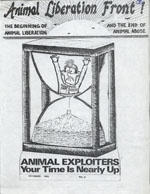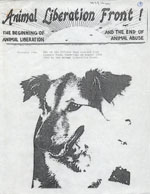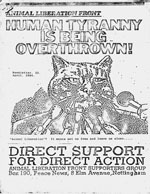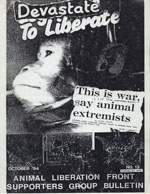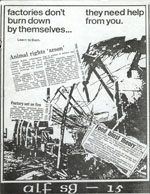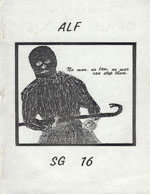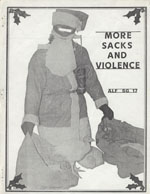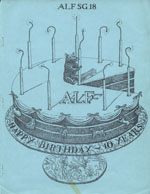The Archives
-
One-off publications
SNARL! Handbook of the Leeds A.L.F.
11.12.13 | PermalinkSNARL! Handbook Of Leeds ALF (1985. Leeds, England)
One of the great things about punk music is also one of the worst things about it: anyone can do it. On the one hand this encourages kids to destroy the adulation of rockstars and to make music (as well as zines, clothes, art, etc) themselves. That accessibility has brought us the voices of people we never would have otherwise heard, which is wonderful. On the other hand, punk doesn’t exist in a vacuum, it came into being in a culture afflicted with bias and brutality, patriarchy, capitalism, and so on. Those elements are ingrained in many of the creators of punk and are, at times, reflected in the works they produce. Those messages are then carried on to those who consume that media.
It isn’t hard to make the leap from an analysis of punk to an analysis of leaderless resistance. Without a hierarchy or organized recruiting mechanism, the A.L.F. has often spread through the same means as punk rock- DIY media, the passion and anger of youth, and at times, sensationalized mainstream media stories. People have heard the call and picked and up the banner, acting on their own initiative to make change. The downside, of course, is that without a training component that goes beyond a few words in a zine about security culture, these newly active saboteurs aren’t always left with the skill set needed to safely or effectively undertake underground actions. They may end up making their own publications which repeat the mistakes of the ones they first read, and these will be passed on to the consumers of that media.
If I were 16 years old and living in Leeds in 1985, I would have loved SNARL. It speaks from a place of youthful (and righteous) rebelliousness, and although the tone can be a little dogmatic, nearly everything else about the “handbook” is just plain cool. I laughed out loud to see license plates, makes and models of undercover police vehicles listed, and was encouraged to see the inclusion of human liberation struggles. That said, the young folks who made this zine were reproducing some of the worst aspects of other publications from the era as far as security and theatrical militancy goes.
SNARL is an interesting product of it’s time, written and distributed by well meaning, hard-fighting folks who no doubt had the best interest of non-humans in their hearts. That said, I hope readers at the time were cautious in following the advice it contained, because much of it was outright dangerous. Looking at the prisoner listings from this period, that doesn’t seem to be the case.
…
-
One-off publications
A.L.F. On Trial – Capitalism Under Attack In The 1980’s
10.29.13 | PermalinkA.L.F. On Trial – Capitalism Under Attack In The 1980’s (1987. England, city of publication unknown.)
On February 5th of 1987 ten British animal liberationists were sentenced to an aggregate of 38 years after a trial prosecutors had designed to “break the back of the ALF.” This case, popularly referred to as the Sheffield Trial, set precedents not only in the UK, but worldwide for the manner in which vegan militants would be tried by the state and media.
Although the Sheffield Trial failed in its goal to end underground direct action for non-humans, it did take a serious toll on the movement. Ronnie Lee was sentenced to 10 years, Roger Yates skipped bail and went on the run, and several others were taken out of the struggle for lengthy periods. The negative media blitz during the trial was among the first to create a popular association between the terms “animal rights” and “terrorist.” Worst of all, Sheffield was the first case in which the charge of “Conspiracy to Commit Criminal Damage” was upheld, essentially allowing radical media producers (In this case Ronnie Lee and the SG Newsletters) to be held responsible for the actions of others the authors had never met or otherwise interacted with- in fact, these other “conspirators” didn’t even have to be known to the authorities. All that needed to be shown was that a publication showed approval for an illegal act and that those acts then continued to occur. (Other courts disagreed with this novel interpretation of the law however, most notably the appeals court in the GANDALF trial.)
Parallels between this case and that of the SHAC 7 and others are clear, but little has been done to learn from the earlier trial. Luckily, an anarchist analysis of the court proceedings from 1987 has survived in the form of this brief, snarky pamphlet.
…
-
Most Popular, Periodicals, The SG (original 80s volume)
The ALF Supporters Group Newsletter – The complete original set!
03.04.13 | PermalinkThe ALF Supporters Group Newsletter #1-19 (1982-1986. Nottingham / London, England)
When this archive project was founded two years ago, a list was made of the ten publications that we “had to have.” Number one was a complete set of the first volume of “The SG.” This was a tall order, and we knew it. First off, the Animal Liberation Front Supporters Group must be one of the most raided entities in England, and its members were frequently raided themselves! The result was that many copies of the magazine ended up in police custody both before and after distribution, never to be seen again. Second, it was a relatively old newsletter, and since the first issues were mimeographed on cheap paper, finding intact copies was going to be difficult. We persevered though, and now these rare pieces of movement history are preserved digitally and online for everyone to read and learn from.
Started by Dave Nicholls in 1982, the ALF Supporters Group was an effort to do two things: 1.) To raise funds for people arrested for animal related direct actions. 2.) To create a broader base of support for the Animal Liberation Front inside the movement. Both goals were met quickly. Within two weeks of their founding, the Supporters Group hit the number of members they had set as their long term goal. Through direct donations, memberships, fundraising events, and sales of merchandise, the SG was able to contribute towards the sizable legal costs of activists being arrested across England.
The newsletter itself went through varying degrees of quality in writing, layout, and value to the movement. The early days of the Nicholls run may have had a drab interior, but the hand illustrated covers were sometimes gorgeous, and the rhetoric had not yet strayed into the more-militant-than-thou nonsense which came later. Eventually the writing would border on the cultish, but there is scarcely an issue of the magazine that doesn’t have some redeeming value. When read critically and as a whole body of work, this magazine follows the rise and spread of underground action for animals across the globe, illustrates the value of coalition building, and provides solid examples of extremism to be avoided through coverage of groups like the Animal Rights Militia. It also provides many historical details found nowhere else!
“The SG” has gone through several incarnations since British Law enforcement shut this one down in 1986. (While carrying out the investigation for the notorious Sheffield trial that sent Ronnie Lee to prison for 10 years, the police raided the SG and charged it’s editors with incitement. Everything published by the SG afterwords had to be run past a lawyer first, but this didn’t stop further raids, arrests, and convictions of those involved in the newsletter.) It is still being published today, copies can be ordered from www.alfsg.org.uk.
Finally, an excellent analysis and critique of the SG and the rise of England’s “Cult of Militancy” can be found in the book Against All Odds, available here at the Talon Conspiracy.
…
-
Periodicals
The Animal Liberation Front Supporters Group Newsletter #17
07.17.11 | PermalinkThe Animal Liberation Front Supporters Group Newsletter #17 (1985, London, England.)
(Editors note: The complete set of SG newsletters is now available HERE.)
It is not usually our habit to put up a single issue of a serialized publication as we prefer to post an entire year, or run of magazines, in a single post. However, we must make an exception for the ALF SG Newsletter #17, which contains a fantastic investigation of the Band of Mercy and comes complete with an image of their first press statement from November of 1973. The significance of that image, the very first communique from an underground group fighting on behalf of other species, can not be understated.
When one considers how entrenched animal exploitation is in our culture, the idea that a tiny band of revolutionaries could push back against that social tide by burning down an animal laboratory under construction is a watershed moment. The arson attacks and raids carried out by the Band of Mercy were pivotal in the creation of the animal rights movement.
This issue has much more in store for readers. The second communique from the Animal Rights Militia is presented in it’s entirety, and although it provides a myopic examination of the role of liberatory violence it is none the less a fascinating read for lovers of animal rights history. The story of the famous Ecclesfield Beagle raid is presented by one of it’s participants, Roger Yates has a long letter explaining his feelings on the uselessness of national groups, and funny pseudonyms abound! If you thought Earth First!ers had funny names, wait till you get a load of Captain Kirk, Martial Rose, and Black Vixen!
If you look carefully you may notice that this issue is missing some pages. We do not know if this is because they were removed by their original owner, or if this is one of the issues of the SG rumored to have been “edited” by the British government as it left post offices on it’s way to subscribers.

…
